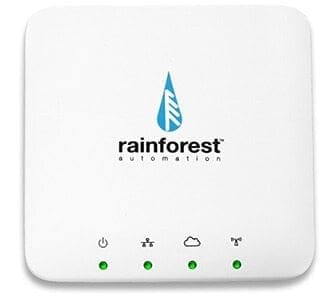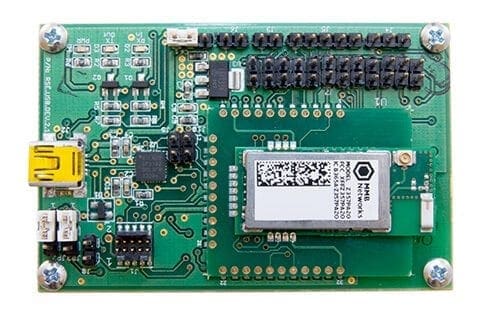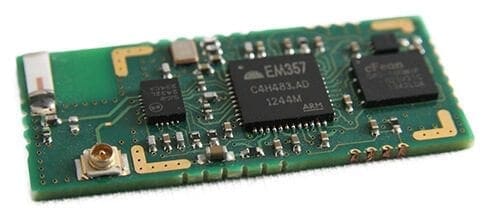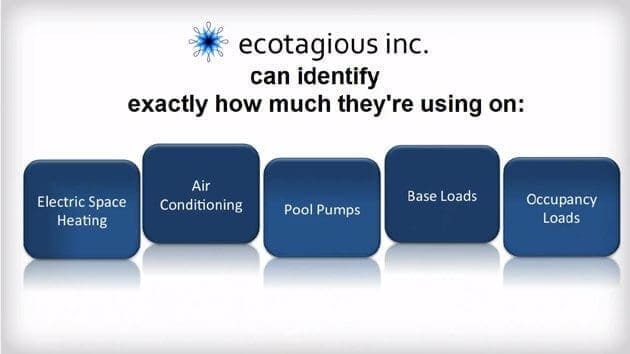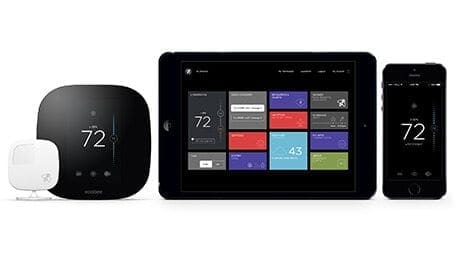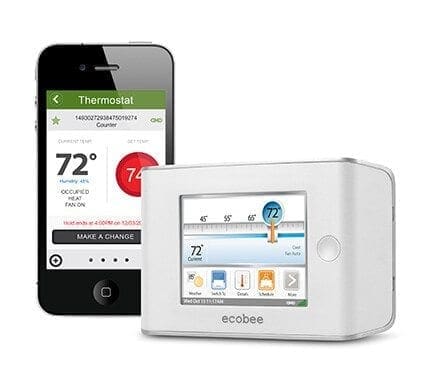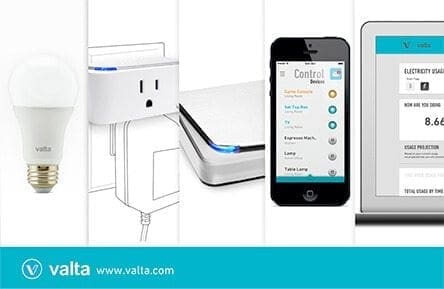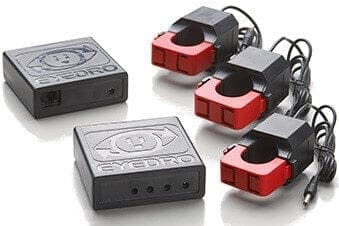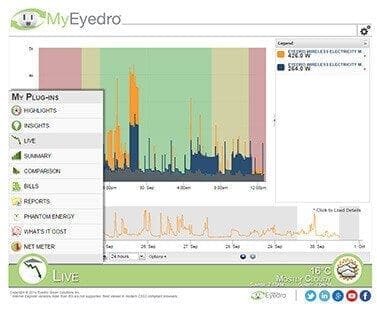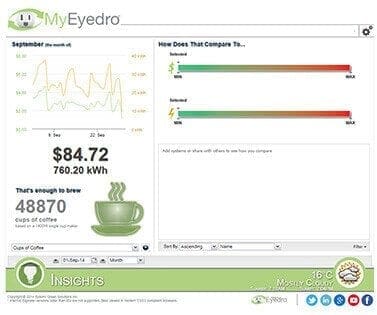The Connected Home: Canadian startups leading smart automation and home energy management
October 28, 2014

This is Part 2 of the sixth report in the Connected World Market Insights Series.
This is the profile section of The Connected Home: Smart automation enables home energy management. For this section we interviewed seven early-stage Canadian companies that are helping shape the connected home and home energy management (HEM) landscape. Their profiles highlight the companies’ approaches to the market as well as their products.
This page contains the following company profiles:

About the companyRainforest Automation is an industry leader in energy feedback products (i.e., technologies that have hardware, in contrast with platforms that do not have a hardware component). The company makes products that enable utilities and their customers to manage real-time energy use. Its home area network (HAN) devices, software products and services enable energy efficiency and demand response programs for utilities, and provide automation convenience and reduced energy costs for residential and commercial consumers. Rainforest Automation’s products are in use across the US, Canada and Australia.   We spoke to Bill Richardson, VP of Marketing, and Chris Tumpach, CEO, to learn more about Rainforest Automation. Chris Tumpach (CT): We basically have two lines of products. One is an in-home display that connects directly to the smart meter via ZigBee radio and gives consumers real-time energy feedback. It’s a really simple device that anybody can use to get a handle on their energy usage. Our other product line is our EAGLE gateway platform. This product connects to the consumer’s home network through a WiFi router. It communicates with the smart meter, pulling energy data from the meter. The product can show this information to the user or push the data to the cloud for additional analysis through any number of third parties. Who are your users? Bill Richardson (BR): We have a large installed user base with thousands of retail users in California. Just this week, we offered them a software upgrade and received hundreds of requests within minutes of the offer. Our users are very engaged. Our next software update, which we will release in in late 2014, will offer control features. The control part allows us to bring other partners into the fold, such as thermostat, load control switch, and smart plug makers. How do you differentiate from your competition? CT: There are two different competitive spaces. There are those [competitors] that come from the utility space who are selling non-intelligent devices—devices that can only read the meter, without capability to upgrade or monitor or manage or do anything with the information. There are other competitors such as SmartThings or Revolv that have built gateways that can connect to various devices. While they’re interesting and users can control things in their house, they do not integrate with the utility and the energy side of the equation, so they are not eligible for utility rebates. The cost of those products ends up being a lot higher. They can’t be controlled by the utility, so neither the utility nor the user gets the incentives to monetize that path. According to our research, customers are not adopting home automation services to manage their energy consumption. They are adopting automation services for security, comfort, health or other reasons. So, how do you see yourself in the connected home space? CT: It’s really interesting. Basically what you have to do is to offer different things to different people and make sure you connect with them. For consumers, you’re right. What they really would like is to control everything through their smartphones. That’s their main goal. So that’s what we provide them. The utility doesn’t really care if the consumer has control through their smartphone. They would like to, occasionally, have their own control.
BR: We have two primary segments. One of them we have mentioned: residential, the normal consumers. But in addition to that, we’re also targeting small commercial users. This is a neglected market. The problem with small commercial— like coffee shops, small grocery stores, convenient stores, that kind of thing—is that they are paying commercial rates, which means they’re paying peak demand charges. But they have no way to manage their energy consumption because they can’t afford the thousands of dollars that it costs for the monitoring equipment, and the hundreds of dollars per month for the monitoring service. Do you see yourselves as another ENBALA or EnerNOC or are you not going that far with demand response? Do you aggregate it? BR: Yes. EnerNOC has big industrial customers. We have a program where we are putting monitors in schools, which is a low-end market for them, but for us, it is big. So yes, we think of ourselves right now as a junior EnerNOC, attacking markets that don’t have the economy of scale because they can’t do the high-volume, low-yield markets. We think that’s critical too for demand response at the residential level… BR: If you look at the growth curves of electricity usage, you’ll see that industrial is fairly flat because they’re well regulated. They’re all in these programs because it makes economic sense for them, but the commercial and residential curves are still growing because they haven hundreds of dollars per demand response. What would you say has been your biggest challenge to date as a startup and in bringing your product to market? BR: Well, as a company, I would say capital was a big challenge. We’re completely self-funded and not by choice, I can tell you that. What about bringing your product to market? CT: The biggest challenge is that this is a new space that nobody is really familiar with. We’re breaking new ground, and when you’re breaking new ground, there’s a lot of education involved. We’re not only educating individual consumers, but educating the utilities as well. We have to be really creative to make what we do fit into what they do. That’s been really important. What do you think is needed to alleviate market barriers? CT: I would say our biggest market barrier has been in being able to work with smart meters and the utilities that have them. Let’s take an example. The state of Florida has deployed five million smart meters, but because the state regulator hasn’t pushed the utility into action, they are purposely not getting started. What are your next steps then? CT: We have some amazing growth opportunities on the horizon. Our goal as a company is to get additional growth funding, hire more people and then go after those markets. We know now in California that for every dollar that we invest in product promotion, we’ll get $20 back in revenue. We believe that we can replicate that in several markets. |
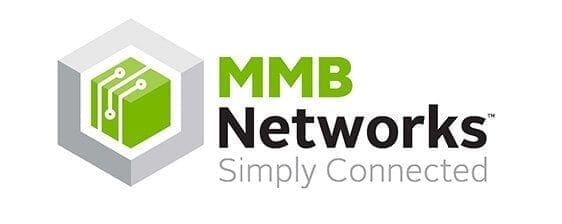
About the companyMMB Networks’ RapidConnect is a hardware and software platform. It enables consumer electronics manufacturers to rapidly add ZigBee connectivity to their products with automated interoperability across major connected-home platforms. MMB’s founders realized early on that with networking technology becoming cheaper and the value of having devices connected increasing, simpler devices were becoming more complex. Companies that manufacture these devices often do not possess the resources, time, expertise or market knowledge to integrate connectivity and bring their products to market through a number of emerging channels. MMB’s founders saw an opportunity. We spoke to Daniel Moneta, CEO of MMB Networks, to discuss the company’s next steps. Who are MMB’s customers? We have a wide variety of customers, ranging from small startups to large multinational and household brands. On the large brand side, one of our customers is Kwikset, an electronic door lock manufacturer that sells products through major retailers under a variety of brands. At the other end of the scale, there’s companies like Zen, which has developed an innovative, beautiful and simple new thermostat, designed specifically to be a good citizen of a connected home. Typically, our clients are companies making some sort of consumer electronics — whether in an established category like thermostats or in new ones like lawn monitoring sensors. They want their devices to be connected and able to join the many and growing number of platforms now available to consumers. For instance, they want to be able to sell the same device to subscribers whether they are using Rogers’ Home Monitoring System, Control4, Lowes’ Iris, Smart Things, Crestron or others. MMB’s software platform allows users to connect to any of these platforms, and to more in the future. Can you describe your product? MMB offers our customers wireless modules that get embedded into their products, enabling them to communicate on connected home networks. These modules are enhanced by MMB’s RapidConnect embedded software platform that automates ZigBee connectivity and interoperability. Today our products are primarily based on ZigBee. ZigBee is a secure, low-power, low-bandwidth, mesh networking wireless standard, which makes it perfect for connected home devices. But a good radio isn’t enough if everyone on it isn’t speaking the same language. So the ZigBee Alliance did something very important, which is to define things in what’s called the “application layer” —defining how devices of certain types should behave and talk to each other on a network. This lets different manufacturers develop devices that will all talk to each other. This isn’t necessarily the case for other protocols. With WiFi, for example, no matter how ubiquitous it may be, a WiFi door lock, a WiFi thermostat and a WiFi remote made by different companies won’t talk to each other. They’ll connect to the same network, but they can’t interact unless those companies have made the effort to work together and integrate each other’s proprietary protocols. That said, even the most robust standard still requires you to implement it, and to implement it well. Product developers, with or without an embedded or wireless engineering team, have to put in a lot of work to create a product that will perform well in consumers’ homes. Their devices have to operate in a variety of wireless environments and interact with any number of other devices and platforms that may not all behave the same way. This is called interoperability. It’s extremely important to the success of a connected product, and product developers spend a lot of time trying to get this right, and make a lot of the same mistakes along the way. That’s a lot of effort spent on a critical, but likely not core part of your product’s functionality.
We’ve automated a big part of that process. Our embedded software, RapidConnect, implements and automates ZigBee Smart Energy or Home Automation standards in a robust way. It’s built on years of MMB’s real-world experience. We convert a lot of complexity and intelligence out to a simple interface that’s easy for product developers to work with. For some of our customers, we’ll even adapt our interface to match one already in their product, so they don’t have to change their device to add connectivity. Beyond just implementing the standard well, keeping up with the rapidly evolving connected home landscape can be a challenge for vendors. There are different platforms, including Icontrol, which powers the Rogers, Comcast, Time Warner, Cox and Peq (Best Buy) platforms, as well as Lowes’ Iris, and Wink, which is now carried by Home Depot and Amazon. They generally all use common standards, mostly ZigBee. But they’re competing with each other, so one of those platforms is going to have three features that the other platforms don’t have, or have different requirements of products in their ecosystem, based on how they’re used. What are your biggest challenges? We started the company as very smart grid-focused. We built our platform around Smart Energy standards—enabling in-home devices to talk to smart meters. Tens of millions of smart meters were rolled out with ZigBee built in, to enable appliances and other devices to use real-time energy data in order to conserve and manage energy. As it turned out, actually getting devices to connect to those meters once they were rolled out was more challenging than expected. Utilities don’t have the same motivation as (and, in fact, have more barriers than) retailers and service providers to enable and support an ecosystem of connected devices for consumers, despite perhaps their best intentions. We’re now just starting to see them turn those features on and let consumers bring energy monitoring devices home. MMB is supporting those efforts, working with companies like Lowes and ADT to link their existing platforms to meters in California, for instance. So that was a major challenge for us: waiting for the market to catch up to what we were trying to do. But now, with the home automation/connected home/IoT market heating up, we’re finally starting to see the acceleration we’d been waiting for. Also, in the past, our challenge had been the scarcity of ways to offer these products to the consumer. Now almost all the major retailers and all the major service providers have a platform. And everyone else who doesn’t have one is trying to figure out what they are going to do.
What needs to be accomplished next to alleviate any remaining market barriers? I think there’s a lot of work still to do in standards, but we’re getting there. There are a few different dominant standards in this space, each with its own ideal uses, and that’s how it should be and probably will be for a while. Nothing is funnier than watching people who are super-biased about particular standards argue with each other. There are different reasons for different types of technology. You’ll always have a little bit of diversity and people will always be competing with each other. It’s the same thing when you’re building apps or accessories. Google is going to have few things that Apple doesn’t have. Apple is going to have a few things that Google doesn’t have. The more diversity, the better our value proposition gets because we’re helping those OEMs [original equipment manufacturers] navigate both the knowledge and the technical capabilities to connect to all of those different channels. Did utilities lose an opportunity? Ontario was ahead of the game in terms of rolling out meters, but didn’t have real-time communication to the home. There are some other technologies, but they are not really a two-way communication. But home automation started to catch up, and it was obviously a lot faster and more innovation-driven than the smart meter- or utility-driven side of the market. We’ve enabled many more devices on the home automation side than on the smart energy side. But now, we’re actually selling a lot more smart energy products that connected home automation systems to smart meters. Instead of the smart meter “talking” to everything in your home, in the new model, the smart meter talks to your connected home solution, such as Rogers, the IDT panel or the Lowes hub. I think this is the right model. Utilities came a while ago to the conclusion that maybe they should just be information providers. In your opinion, what’s next? I think soon you’re going to see major service providers or connected home platforms starting to manage as much load as utilities, and have far greater control over it. This is going to enable big advances in the smart grid, including both renewables and distributed generation. Companies like Apple, Google and Amazon are building power plants just to feed their data centres. They are getting good at that and they are going to be able to start putting power into the grid. Increasingly, especially as we move towards renewables, the biggest value in demand response will be in matching demand to capacity. Whoever is in control of the load will have the most leverage. |

About the companyEcotagious helps utility companies meet their energy conservation targets by breaking down smart meter data into insightful and useful information for customers. The premise is that the more the customer understands how they are using their electricity, the more likely they are to take action to conserve. Ecotagious has developed a SaaS (software-as-a-service) product that allows utility companies to provide appliance-level feedback to customers. The software requires no additional hardware aside from the smart meter. By being able to target feedback on specific loads, such as air conditioning or electric space heating, Ecotagious can help utilities shape their profiles for summer or winter loads, reduce peak demand and drive customer satisfaction.  How many employees does Ecotagious have? What are their backgrounds? There are eight of us right now. Salim Popatia is our VP of business and development and has about 15 years of experience in sales, marketing, government affairs and people management in the pharmaceutical industry. He’s very familiar with selling into highly regulated markets. Mike Walsh has about 17 years of experience running a software-as-a-service company that delivers stakeholder engagement services to municipalities and other companies. David Berkowitz is our executive chair, and has 15 years of experience in the venture capital industry. That’s our senior management. What are the company milestones? We released our first alpha product to utilities in 2012. We ran a pilot of our second-generation SaaS offering, which delivers conservation, to utilities in the first quarter of 2014. We commercially released that same product later in 2014, and within months signed on seven utility customers. What distinguishes Ecotagious from its competitors? Two things. First, because we can disaggregate smart meter data to major appliance loads, we can deliver high customer satisfaction. Customers appreciate getting more information about how they are using their electricity. This is something they have never had before. They feel like their smart meter is working for them.
Who are your main customers right now? Some of our customers are Greater Sudbury Hydro, PUC Distribution and Northern Ontario Wires. How much capital have you raised and from what sources? We have raised capital, but we haven’t disclosed how much. We prefer to keep that information private. What is the company’s biggest challenge? The biggest challenge has been accessing the large amounts of data that we need for our algorithm and our smart meter data analytics. It is not only a technical challenge, but also a commercial and a market one. What has been the most exciting part of building the company? Building the right team to bring the product to market has probably been the most exciting part of it. We’ve got a fantastic team in place, so it’s fun to come to work. The team is dedicated and driven and we’re all focused on the same objective. And what has been the most challenging part? Having the time to pursue all the opportunities that are available. As a small company, we are resource-constrained, so we have to be very deliberate about the opportunities that we pursue. Yet, we see with smart meter data analytics an enormous amount of opportunity. We have to be very judicious in how we deploy our resources. What do you think is needed to alleviate market barriers? Initiatives like Green Button, for example? Standards like the Green Button absolutely will help alleviate some of the barriers. I think that’s probably the biggest one. As utility companies and their suppliers, like meter data management repositories, become more familiar with deploying our analytics, it will alleviate another associated barrier. You’ve been in the market for a while. What trends do you see? What changes are affecting the sector? We’re beginning to see recognition by utilities of the value of smart meter data analytics in driving conservation as well as customer satisfaction. We’re starting to see much more interest and confidence in the value that our software-as-a-service offering can provide. There’s still a huge opportunity ahead, but it’s starting to gain momentum. Ecotagious just ran a pilot with Greater Sudbury Hydro. What were your main findings? We ran a pilot with Greater Sudbury Hydro last winter, from January through April 2014. During that pilot, we discovered we were able to deliver over 4% conservation in the fourth month after launch, across the residential segment that we served. This proved a few things: the ability of our product to drive the specific conservation the utility wanted (winter energy savings), rapid deployment and impact of a turn-key program for the utility company, and high customer satisfaction as a result of delivering reports to customers. Where do you see Ecotagious six or eight months from now? We see Ecotagious continuing to grow quickly throughout North America and Europe. |

About the companyecobee’s mission is to help consumers use technology to conserve energy, save money and reduce their environmental impact. The company recognizes that 50% to 70% of a home’s energy use is spent on heating and cooling, so it manufactures WiFi-connected thermostats to help consumers conserve more. We asked Stuart Lombard to tell us more about his product and where ecobee is headed.  Tell us about the product. How does it work? ecobee makes WiFi connected thermostats that control your heating and cooling system. The thermostat connects to the Internet and, once connected, it can be controlled through a smart phone or a tablet. Our newest product, the ecobee3, solves a design flaw that has existed in thermostats for decades: the problem of only measuring temperature in one location, often the hallway. ecobee3 is different. It works with wireless remote sensors to measure temperature and occupancy in multiple locations to make you more comfortable when you’re at home and save you energy when you’re away. Does your solution provide only feedback—or advice too? For consumers, we provide feedback on what the right temperature is when they are not home, based on outdoor weather, home performance and heating and cooling system equipment performance. Our newest product includes remote sensors that measure both occupancy and temperature. They provide two really unique features. The first one is called “follow me.” One of the biggest problems with thermostats is that they’re not necessarily installed in the rooms that the consumers use. By putting a remote sensor in that room, we know when a consumer is in that room and we can control your heating and cooling system to deliver better comfort to the rooms that you use. What are ecobee’s biggest milestones? The first milestone was to start the company: to quit what you’re doing, to quit your day job and to actually jump in the pond. Another huge milestone was to ship the first product. That was clearly a big milestone for us. I think the next milestone is feeling that you’ve understood the processes to make the business work and customers start actively seeking you out to buy your product. We’re starting to cross this milestone at ecobee.
Who are ecobee’s customers? We are very focused on families who use technology to make their life simpler or better, but who are not necessarily very technical. They’re people who love their iPhones, love their tablets, are engaged on the internet, whether it’s Facebook or social media, and are looking for other ways for technology to simplify their lives. Typically, it’s young families who are looking to put a nice product in their home that’s going to look great on their wall and who are comfortable using technology to make their lives simpler. Has ecobee done any fundraising? Yes, we have. We’ve raised capital from venture capital sources. For example, Relay Ventures, Tech Capital Partners and the Ontario Capital Growth Corporation are investors in the company, as are some of our largest customers. What would you say has been your biggest challenge? I think the biggest challenge is the focus. As a startup, what you need to be successful is great word-of-mouth. To get great word-of-mouth, you need to build a really great product. You need to focus on all of the details that make a product truly exceptional: making sure the product does what your customer wants and that you deliver on the value proposition that you promised. As you grow the company, as you get successful, one of the challenges is that people want to do more with your product and start using it in different ways. Then you’re exposed to a lot of opportunities and I think is critical to keep focused and to understand when to say no. I think that’s the biggest challenge. Is it easier now because you have previous experience in running startups? I think it’s both easier and harder. When I started my first business, I had nothing. I remember the day I quit my job. I packed everything I had into eight boxes and I moved back home with my dad. I had nothing to lose. In the worst case, I was going to go back and get another job. In some ways, starting ecobee was harder because I had, frankly, a lot more to lose. What’s your market? Are you selling in the Canadian market only? We sell in both the US and Canada.
Do you think it’s easier or more difficult to sell in Canada? No, I don’t think it’s more difficult. I think if you’re a Canadian startup with a consumer technology product, you need to be focused on a market outside of Canada to have a larger addressable market. Our belief is that if we can’t sell in the US, which is close to us and speaks the same language, we’re not going to sell anywhere. We’ve been very successful selling in that market—about 90% of our sales are in the US. What’s next for ecobee? World domination! [laughs] We’re in a market that’s growing very rapidly. It’s really at an inflection point and we’re trying to manage the growth. We’ve doubled our employee base over the last year, which is a big challenge, and we want to make sure we deliver a great experience to our customers. That’s what we’re focused on right now. What are the major trends or changes in the sector that you’ve seen in the last couple of years? I think the biggest change is consumer perception. When I left my position with a venture capital firm to start a company that makes WiFi-connected thermostats, people looked at me like I was crazy. What’s really exciting and gratifying is that the public perception and the market perceptions have gone from “are you nuts?” to “wow, that’s kind of cool” to “hey, I’ve got an ecobee in my house.” That’s just really, really cool to see. |

About the companyFounded in 2011, Liricco has developed an energy management platform called Valta that consumers can use to automate their devices to fit their lifestyle. Users plug the control hub into their router and plug the socket into an outlet, and then they can connect to any device they want to control and monitor. Users gain instant total control of their devices, and within 24 hours, the Valta cloud server identifies savings opportunities. 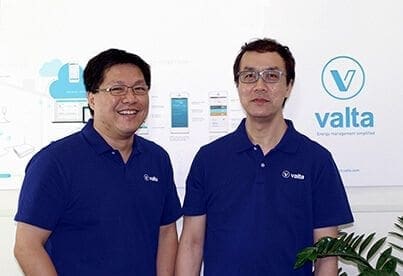 We interviewed Jeff Lin, co-founder (the man on the left in the photo, standing beside co-founder K.C. Li) to learn more about Liricco. How did the company start? Two of my partners and I went to the CES conference, probably around four years ago, and started thinking about the next big thing. The Internet of Things was gaining momentum. And we were seeing the basis of a huge energy crisis throughout every market in the world. How long has Liricco been in business? Since 2011. And I think we have accomplished a lot in a short time. Our solution is a platform solution, which means it’s infinitely scalable. Our control hub is pretty cool. Right now, on top of the energy management functionality, it is probably the best and most functional socket out there. It’s the smallest in size and the best in class in terms of range. We’re not using WiFi or ZigBee. We’re using a proprietary RF [radio frequency] that enables us to reach a range of 45 m, with the lowest energy signature of any socket system, at 0.5 W. It’s proprietary, so your information is secure. What are the company’s milestones? We have five patents in various jurisdictions, including the United States and China, which enables us to get patents for the rest of the world. In 2014, we won the Good Design Award in Japan, and the gold medal in invention in Geneva. What distinguishes Liricco from its competitors? We have better range. With WiFi and ZigBee, you’re talking of one to one, from the socket to the router. It covers probably 10 m, and, after that, if you don’t have a repeater or an enhancer, it gets a bit iffy. Our range is 45 m and counting. We also have the lowest energy signature at 0.5 W, and the best security. Our installation process is super easy. It is basically plug and play. Our cloud analytics use the energy information to achieve something tangible. It helps you save energy and, therefore, money. It is automation with a purpose.
Our biggest competitor is Belkin, but I believe we have a better product. Function-wise, we have better range (45 meters/150 feet), better in-building penetration, better security, lower energy consumption (0.5 watt), and much sleeker design that fits seamlessly into the user’s environment. In addition to that, we enable connected devices to achieve something tangible, that of energy savings. There are other energy management solutions out there, like ThinkEco, but we think their solution is extremely complicated, difficult to set up, and hard for the average end user to disseminate. Valta is a simple plug & play system that brings clarity to energy savings. Who are your customers? We’re selling on Amazon. And we are about to go into a pilot program with the three biggest utilities in California: SCE (Southern California Edison), based out of Los Angeles; PG&E, which is in San Francisco; and San Diego Gas and Electric. California is having trouble convincing people to, for example, do their laundry at night. Right now, even with the peak rates, users are not changing behaviour. So with our app, we could show them the benefits in terms of dollar and cents. We are changing behaviour by providing information that’s relevant to the end user. What are Liricco’s main challenges? I’m a bit frustrated being in Canada because our power is so cheap. We’ve invested so much in power generation that we are probably only region in the world that actually needs to pay others to take our excess power. Being energy efficient from the demand side is not looked at as an important issue. For example, Californians are becoming a lot more energy conscious, as they are turning down numerous nuclear power plants after the Fukushima disaster in Japan. They are facing a supply crunch. In Germany, they have realized that they need to focus on renewable and their utility rates are a lot higher to reflect that change. Thus, a product like ours carries a lot more appeal abroad because the payback is a lot quicker. What do you see as your main market barriers? I think it’s about awareness. The way we’re doing energy right now is not sustainable. We can all see the impacts of climate change, so we need to figure out renewable energy and conservation. High energy production, which leads to one of the lowest energy costs in the world, does not help. We would love to work with the energy commissions here in Canada to foster a more sustainable energy policy—one that is more mainstream in relation to the rest of the western world. Upping production infinitely is not sustainable. What’s your market opportunity? For our product, the market opportunity’s quite big. For example, in Germany, where utility rates are four times that of Canada, a product like mine installed in the right devices could pay for itself within six months. California is a ready market with huge potential. Many countries in Asia are looking at whole scale connected solutions to optimize new developments and urbanization plans. How much have you invested in the company so far? My two partners and I have spent a bit over US$1 million over the past two and a half years. It has been quite an expensive science project. Where do you see Liricco in six months or a year from now? We’re going through a round of fundraising right now. We have talked to BDC [Business Development Bank of Canada], and a lot of venture capitalists in Hong Kong. Once the round of fundraising is done, I see the company doubling to tripling in size, both in Toronto and Hong Kong. Then we’re going to expand to at least 10 different markets. |
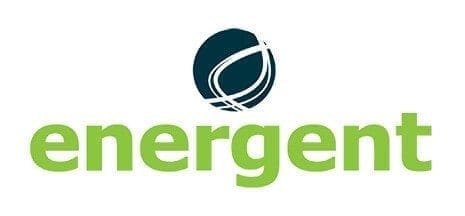
About the companyEnergent Inc. provides state-of-the-art energy management information system solutions, or “in-depth energy informatics,” as Jill Clark, Energent’s Marketing Specialist, explains it. The company collects all energy data associated with a site, either through electronic transfer, on-site integration to control systems, or metering infrastructure. Then, through mathematical models that incorporate a wide range of variables such as weather, occupancy levels, production and facility operations, Energent baselines the energy profile, providing a reference point for continuous improvement. Approximately 5% to 10% can be saved through low or no-cost actions, simply by having this level of analytical insight. We spoke to Jill Clark to learn more about this rising startup’s next steps.  What is the company background? Energent started in 2007 and was previously named Northern Dynamic. There were a number of products and services that ND provided, but after solving a problem related to energy management systems at GM Canada, the company focused its efforts on commercializing that solution and taking it to market for other companies. In late 2007, the company was renamed Energent, to put an emphasis on the intelligent use of energy. Can you talk about your team? The Energent team is made up of people who are truly passionate about energy management and sustainability in general. Currently the team is about 10 to 12 people. We’re a small team, but very dedicated and hard working— a wonderful group of people to work with. What distinguishes Energent from its competitors? With recent attention to the rising cost of electricity, and energy in general, many more companies have entered the energy management information system market. There are also initiatives such as Green Button making the process of energy data collection easier, particularly in the residential and commercial sectors. But the modelling and analytics that turn this raw data into information is where Energent stands apart from most other companies. Could you explain your product development cycle? At Energent we made talking to our customers one of our biggest priorities. As such, this is how we really prioritize our development efforts. We talk with our customers and understand what they need from our software and services to make the management of energy easier for them. Our business model is SaaS, or software-as-a-service, so it enables us to develop new functionality and immediately make it available to all of our subscribers. Who are Energent’s clients? Our clients are in diverse industries. Since our software system is scalable and flexible, we can address applications ranging from small footprint retail all the way up to large industrial. Principally we work with Fortune 500 industrials, large commercial property management firms, retail chains, and portfolios in the MUSH sector [municipalities, universities, schools and hospitals]. What are your main challenges? As an industry, the number one challenge in North America, ironically, is that energy prices are still relatively cheap in comparison with other regions of the world. So telling clients “you should reduce your energy consumption” sometimes doesn’t resonate with them, as they don’t always see a great financial benefit in doing so, at least in comparison with other initiatives competing for both management funding and attention. But this is changing. The continued rise in energy prices is inevitable, and in order to meet long-term predicted energy requirements in electricity, conservation and demand management are going to be instrumental. Where do you see Energent a year from now? Energent will continue to focus on innovation in energy modelling and data analytics, providing these innovations to our customers through our EMIS [energy management information systems] solutions. We also want to continue to leverage Ontario’s focus on the smart grid in our Energy Hub research collaboration—maturing and eventually commercializing that technology and bringing it to the market in Ontario and beyond. A year from now Energent will again have grown both in terms of revenues and staffing, and will continue to partner with other key players in the energy space. There is also a lot of consolidation underway in the energy modelling and data analytics space, so who knows? The landscape is continually changing. |
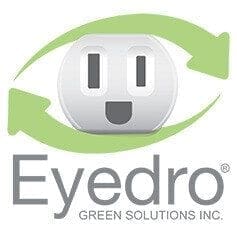
About the companyEyedro’s goal is to help customers track their electricity usage and costs in real time. The idea for Eyedro started in 2011 when one of the partners, Nick Gamble, started investigating his father’s electricity bill, which was close to $700. Nick, who was a home inspector at the time, had the idea of helping home builders and new home buyers understand their electricity use. Trevor Orton, one of Eyedro’s co-founders and CEO, was completing an MBA at Wilfrid Laurier University at the time. He liked the idea and decided to write a business plan. Gamble and Orton took it from there. We spoke to Trevor Orton to learn more about the Eyedro’s solutions and future challenges. Can you tell us a bit about your product? The initial vision was to help homeowners. But it has evolved. Eyedro is a real-time electricity monitor: a piece of hardware that customers can install in different places. In factories, it can be installed on a machine. Landlords can install it for tenants. And homeowners can put it in their home. Clients can see the electricity usage at a building or machine level. Our product connects to the Internet, so clients can use it through our website. Eyedro is a real-time monitor, which also includes free access to the MyEyedro.com cloud service solution.  What is Eyedro’s competitive advantage? Smart meters are useful, but they stop at the wall of the building. If you want to measure at the machine level, you need something inside the smart meter. This is one of our differentiators. What have been your major company milestones? We launched our products in 2011. Since then, we have been selling both our hardware and our cloud service and they are fairly mature now. The focus right now is around sales. There is a huge market in front of us. The next major milestone is to land additional projects. Who are your customers? Describe the different customer segments you have and who you are targeting. We look at different verticals. The large industrial customers are an excellent fit for Eyedro. These companies have an energy manager who needs to understand where the energy is going. The commercial segment has a similar model, with energy managers who want to understand where the dollars are going from piece of equipment to piece of equipment. Until now, all they’ve had is the electric bill that stops at the wall. What do you think is needed to open up the residential market? There are political, economic, environmental and social factors. I think continuing to educate the public on how we can be smarter about our energy use is important. The fact that renewable energy is growing is great, but it also increases the price of electricity. As the price increases, it helps motivate the public to care. Projects like Green Button are going to be of huge benefit for Ontario. It’s going to help educate the public and it’s going to give customers a no-cost channel for their smart meter data. We’re participating because we think it’s the right thing to do—but also because as customers become better educated on their energy usage, they are going to want more details. And smart meters will only give them so much detail. Eyedro can take them to the next level.
What would you say has been your biggest challenge to date? Fundraising in the early stage, which is a very common problem for startups. It takes time and energy to build something from nothing and we developed this product from scratch. We have a second challenge with staffing and bandwidth. I would love to have a team of ten instead of five, but I need to generate more revenue to hire more people and I need more people to generate more revenue. And the challenges of bringing your product to market? Bringing the product to market is actually pretty easy. It’s more about the sales. The product has been for sale for a while and customers love it. So it’s a marketing challenge. How do we get access to more customers? How do we build our brand? How do we make everyone aware? How much capital have you raised? Is it from investors or banks? We have raised approximately $800,000 from investors. These days banks are probably the last place where a startup would get money. Just last May [2014], we had a major investment from Waterloo North Hydro. Is there anything you can share with us about Green Button? The Green Button pilot with London Hydro, Hydro One, MaRS, the Ministry of Energy, Eyedro and a few other vendors is exciting because it’s all about providing consumer electricity usage information at no cost. We expect that once consumers get a sample of what it’s like, they will be encouraged to adopt a real-time device like Eyedro. Is Eyedro providing that real-time capability? A Green Button customer has access to their smart meter data. So when they use our cloud service they have access to that specific information. But they can also purchase an Eyedro device to get that real-time capability. We don’t control smart plugs today, but our newest version of the product moves us towards load control capability. Are you looking at building relationships with complementary companies throughout this value chain? Absolutely. We are already working with competitors and partners. We allow our hardware competitors to use our cloud service and to private-label our cloud service as their own. We also sell our hardware to our software competitors. We are happy to work with everyone. This is a huge market, so there is no reason not to work together. In the last couple of years, what major trends or changes have you noticed in the sector? Where do you see it going? It’s definitely growing. Some of the statistics I have show that there is a multi-billion dollar market for home energy management systems and building energy management systems. And the market is continuing to grow. What are the next steps for Eyedro? Currently, the basic web service is free. As we continue to grow, we will be adding value-added features for a fee. We look forward to rolling out premium services in early 2015. |
[download url=”https://www.marsdd.com/wp-content/uploads/2014/10/Oct28-MaRS-ConnectedWorld-ConnectedHome.pdf” type=”pdf”]The Connected Home: Home automation enables home energy management[/download]
The Connected World Market Insights Series
The Connected World Market Insights Series will cover such topics as:
- Advanced metering infrastructure (AMI) and smart meters: Building upon a home advantage
- Automation and energy: Unlocking home and building energy management opportunities
- Entertainment for the connected home
- Security: Privacy, data ownership and data risk
- Transforming health: Decentralized and connected care
- Connected mining opportunities and new technologies
- The value of real-time meter data
We’ll highlight the innovators in industry, academia and government throughout this series. In fall 2014, we will cap the series with HomeConnect 2014. This event will feature some of our companies, alongside major industry players, as they showcase their technology and solutions.
Accessing data is key, but we think that being able to format and analyze that data is where the real value can be found. During this series, MI will delve into the market opportunity now becoming available due to progress in opening up datasets, and the development of infrastructure and analytics that are creating new services and products and bringing them to market.

